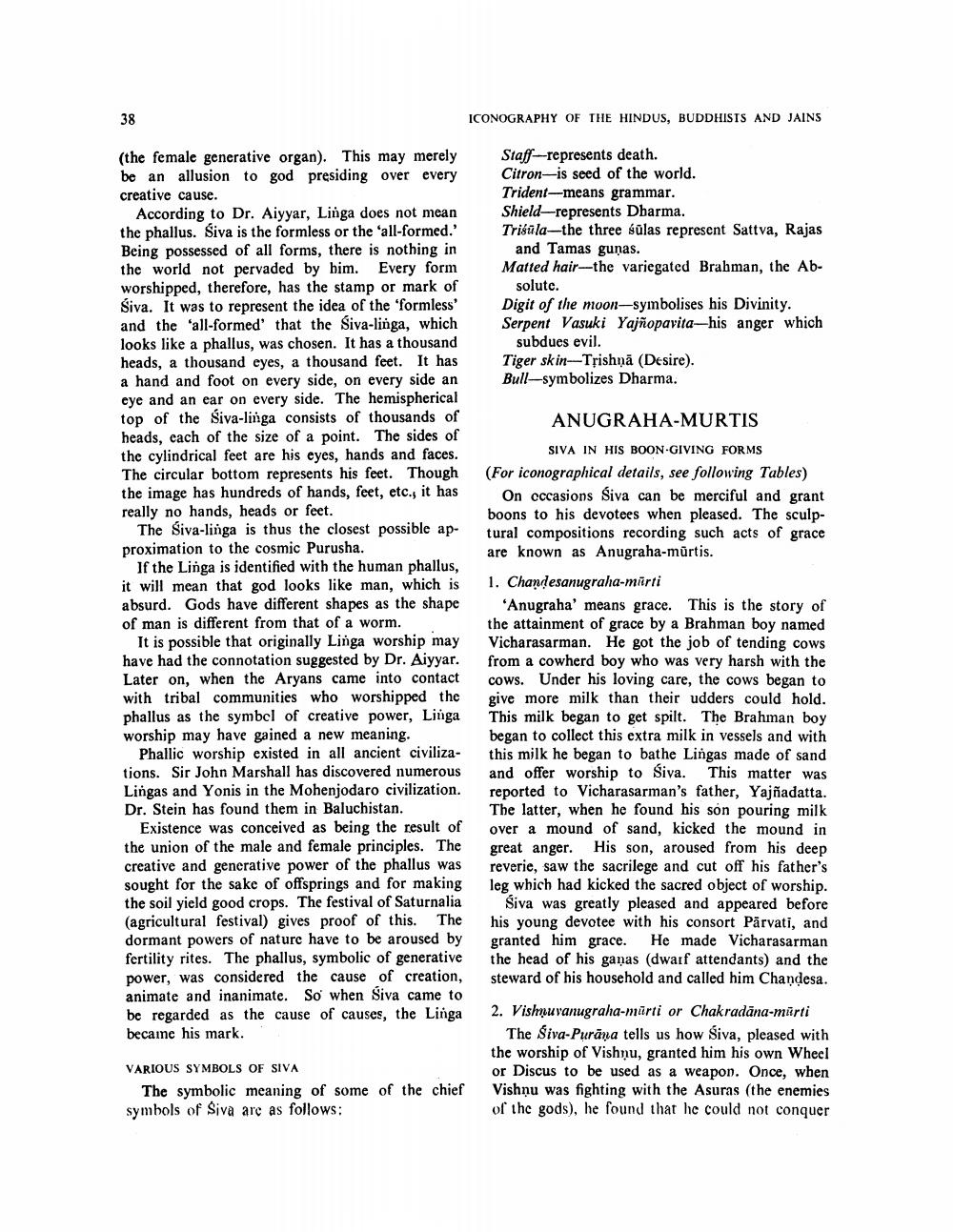________________
ICONOGRAPHY OF THE HINDUS, BUDDHISTS AND JAINS
Staf-represents death. Citron-is seed of the world. Trident-means grammar. Shield-represents Dharma. Trisula-the three sūlas represent Sattva, Rajas
and Tamas guņas. Matted hair--the variegated Brahman, the Ab
solute. Digit of the moon-symbolises his Divinity. Serpent Vasuki Yajñopavita-his anger which
subdues evil. Tiger skin-Trishņā (Desire). Bull-symbolizes Dharma.
(the female generative organ). This may merely be an allusion to god presiding over every creative cause.
According to Dr. Aiyyar, Linga does not mean the phallus. Siva is the formless or the 'all-formed.' Being possessed of all forms, there is nothing in the world not pervaded by him. Every form worshipped, therefore, has the stamp or mark of Siva. It was to represent the idea of the 'formless' and the "all-formed that the Siva-linga, which looks like a phallus, was chosen. It has a thousand heads, a thousand eyes, a thousand feet. It has a hand and foot on every side, on every side an eye and an ear on every side. The hemispherical top of the Siva-linga consists of thousands of heads, cach of the size of a point. The sides of the cylindrical feet are his eyes, hands and faces. The circular bottom represents his feet. Though the image has hundreds of hands, feet, etc., it has really no hands, heads or feet.
The Siva-linga is thus the closest possible approximation to the cosmic Purusha.
If the Linga is identified with the human phallus, it will mean that god looks like man, which is absurd. Gods have different shapes as the shape of man is different from that of a worm.
It is possible that originally Linga worship may have had the connotation suggested by Dr. Aiyyar. Later on, when the Aryans came into contact with tribal communities who worshipped the phallus as the symbol of creative power, Linga worship may have gained a new meaning.
Phallic worship existed in all ancient civilizations. Sir John Marshall has discovered numerous Lingas and Yonis in the Mohenjodaro civilization. Dr. Stein has found them in Baluchistan.
Existence was conceived as being the result of the union of the male and female principles. The creative and generative power of the phallus was sought for the sake of offsprings and for making the soil yield good crops. The festival of Saturnalia (agricultural festival) gives proof of this. The dormant powers of nature have to be aroused by fertility rites. The phallus, symbolic of generative power, was considered the cause of creation, animate and inanimate. So when Siva came to be regarded as the cause of causes, the Linga became his mark.
ANUGRAHA-MURTIS
SIVA IN HIS BOON-GIVING FORMS (For iconographical details, see following Tables)
On occasions Siva can be merciful and grant boons to his devotees when pleased. The sculptural compositions recording such acts of grace are known as Anugraha-mūrtis. 1. Chandesanugraha-mirti
'Anugraha' means grace. This is the story of the attainment of grace by a Brahman boy named Vicharasarman. He got the job of tending cows from a cowherd boy who was very harsh with the cows. Under his loving care, the cows began to give more milk than their udders could hold. This milk began to get spilt. The Brahman boy began to collect this extra milk in vessels and with this milk he began to bathe Lingas made of sand and offer worship to Śiva. This matter was reported to Vicharasarman's father, Yajñadatta. The latter, when he found his son pouring milk over a mound of sand, kicked the mound in great anger. His son, aroused from his deep reverie, saw the sacrilege and cut off his father's leg which had kicked the sacred object of worship.
Siva was greatly pleased and appeared before his young devotee with his consort Pärvati, and granted him grace. He made Vicharasarman the head of his ganas (dwarf attendants) and the steward of his household and called him Chandesa.
VARIOUS SYMBOLS OF SIVA
The symbolic meaning of some of the chief symbols of Siva are as follows:
2. Vishnuvanugraha-mūrti or Chakradāna-marti
The Siva-Purāņa tells us how Siva, pleased with the worship of Vishnu, granted him his own Wheel or Discus to be used as a weapon. Once, when Vishnu was fighting with the Asuras (the enemies of the gods), he found that he could not conquer




